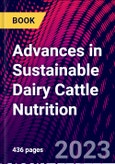Tackling the Burping Cow With Optimised Nutrition
Global demand for milk and other dairy products continues to grow. As a result of this increased consumer demand, the sector’s greenhouse gas (GHG) emissions have risen dramatically. It is therefore crucial that the livestock sector reacts to these developments and considers areas for improvement that could reduce the sector’s contribution to climate change.
Advances in sustainable dairy cattle nutrition provides a comprehensive review of the wealth of research on recent advances in understanding and improving dairy cattle nutrition to reduce the carbon footprint of the dairy sector. This collection explores the role of nutritional requirements in optimising gut function and overall animal health, as well as its influence on milk yield and quality. Chapters also review the use of dietary supplements, such as plant extracts and direct-fed microbials (DFM) to optimise dairy cattle nutrition.
Key Features:
- Reviews advances in our understanding of key nutritional requirements (carbohydrate, protein, lipids) and their utilisation in dairy cattle production
- Considers how a greater understanding of dairy cattle nutrition could improve the sustainability of the dairy sector and reduce its contribution of GHG emissions to the atmosphere
- Assesses the development of alternative feed sources from agricultural co-products, including sources of fibre from fruit pulp, protein from distillers grains and starch from cereals
Audience: Dairy science research community, environmental scientists, veterinarians, animal nutritionists government and private sector agencies tackling climate change and supporting sustainable livestock production as well as feed and dietary supplement manufacturers.
Table of Contents
Executive Summary
The livestock sector and its supply chains are recognised as significant contributors to climate change, with livestock production responsible for around 14.5% of the world’s total anthropogenic greenhouse gas (GHG) emissions.
Dairy and beef production is said to amount for 62% of these emissions, with other livestock species such as poultry, pigs, buffalo and small ruminants accounting for the rest.
Significant amounts of research effort has been allocated to developing mitigation strategies that can be implemented by livestock farmers across the world to improve the sector’s sustainability.
One particular area of interest is the relationship between livestock nutrition and the production of GHG emissions.
The book 'Advances in dairy cattle nutrition' - extensively reviews how key stakeholders across the dairy supply chain can optimise nutrition as a means of reducing the dairy sector’s carbon footprint.
“Before dairy cattle nutrition can be optimised, it must be understood,” says Francis Dodds, Editorial Director at Burleigh Dodds Science Publishing.
“The first few chapters of this new book give an overview of the recent advances in understanding the role of nutritional requirements in optimising gut function and overall animal health, as well as its influence on milk yield and quality,” he adds.
The book then proceeds to explore an array of different dietary supplements available to optimise dairy cattle nutrition, including plant extracts such as condensed tannins, essential oils and saponins and other supplements such as probiotics, exogenous enzymes and amino acids.
“Professor Hristov has compiled an outstanding list of dairy scientists and educators,” says John P. McNamara, Emeritus Professor of Animal Science at Washington State University.
“The book summarizes the key knowledge in dairy nutrition and feeding required to develop effective new strategies to support a resilient and climate-friendly dairy food production system for the foreseeable future,” he concludes.
Soybean meal is the most common and widely used protein source in dairy cattle diets. However, as a result of climate change and increasing costs, farmers are seeking alternative protein sources to supplement the diets of their herds, such as that of seaweed and microalgae.
The final part of this new book assesses current alternative feed sources from agricultural co-products, focusing primarily on alternative fibre and protein sources.
“This book will be a comprehensive compilation of current knowledge on a topic that is highly relevant,” says Professor Pekka Huhtanen, Swedish University of Agricultural Sciences, Sweden.
“It will be an important reference source for dairy scientists, advisors and students,” she concludes.








